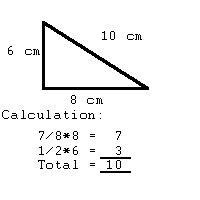"In any right triangle, the area of the square whose side is the hypotenuse (the side of the triangle opposite the right angle) is equal to the sum of the areas of the squares of the other two sides."
so the hypotenuse can be calculated as h = (a² + b²)½, that is square root of (a² + b²). But there is an amazing theorem in Tamil, rather a statement to find out the hypotenuse without the use of square-roots. This was stated, by Bodhayanar or Buddhayana, even before the time of Pythagoras. The statement goes like this
"Odum Neelam Thanai Ore Ettu
Kooru thaaki Koorilae Ondrai
Thalli Kundrathil Paadhiyai Saerthal
Varuvathu Karnam Thane"
which means split the base (Neelam) into 8 equal parts (Kooru) and subtract 1 part from it and add half the height (Kundru) which gives the hypotenuse (Karnam). So lets work this out with an example. Consider a right triangle, of dimensions base 8 units and height 6 units so according to the pythagoras theorem the hypotenuse is square root of (64 + 36) which is 10. Now lets try the same with the above theorem
Divide the base into 8 equal parts so in this case each part is 1 unit
Subtract 1 part from the 8 parts so the remaining is 7 units ----- (1)
Add half the height which is 1/2 of 6 = 3 units -----(2)
Now adding (1) and (2) gives the total 10 units which is the hypotenuse of the triangle.
 Amazing isn't it? Also if you notice there is no use of any square roots, but simple basic arithmetic addition, subtraction, multiplication and division. The only condition for this to work is that the base has to be greater than the height. So we can summarize the above as follows. If x, y are the base and height of a right triangle respectively then the hypotenuse
Amazing isn't it? Also if you notice there is no use of any square roots, but simple basic arithmetic addition, subtraction, multiplication and division. The only condition for this to work is that the base has to be greater than the height. So we can summarize the above as follows. If x, y are the base and height of a right triangle respectively then the hypotenusez = 7/8*x + 1/2*y where x > y
This works 100% accurately for all integral pythagorean triplets (i.e, the right triangles with dimensions that are round numbers like [3,4,5], [8,6,10], [5,12,13] etc) for the others it works with 95% to 99% accuracy
I don't have any rigorous mathematical proof to it, but it works!
More to come, until then...

9 comments:
Really good information! Where do you get this info!!
That was good !!!
Interesting observation, but your statement that it works for all integral Pythagorean triplets is incorrect - which is obvious because you cannot replace a polynomial equation with a linear one. I tested it on around 45 Pythagorean triplet listed on
http://www.friesian.com/pythag.htm, and the result only held for 4 of them - (3,4,5), (5,12,13), (6,8,10) and (10,24,26).
Indeed, Arish is right. thanks Arish. I had hypothesized, the fact from an article that i read way back, but i must admit that i did not try out all the possibilities though. This also is a point of caution to me, that i should not post the certainty of statement before analysing it completely. Apart from this, what i would like to emphasise is that the fact is quite intriguing and it has reasonable accuracy, if not exact for most cases
Very interesting.But its not working for the triplets (7,24,25),(20,21,29)etc.Do u have any other formula?
As mentioned in the previous comment, this formula is an approximation and does not work accurately for all the integral triplets.
Pl help me to clarify, if base is 8 cm and height is 4 cm the hypotenuse works out 9 cm as per Bhoothaiyanaar, which is correct, but does not satisfy pythogorous theory. Can you pl clarify.
@Ramanarayanan, The calculation by Bodhayanar is an approximation the actual Pythagoras theorem 4*sqrt(5) ~ 8.944
Very thoughtful blog
Post a Comment